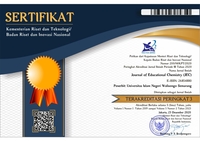Chemistry Learning Outcomes Assessment: How is The Quality of The Tests Made by The Teacher?
DOI:
https://doi.org/10.21580/jec.2021.3.1.6582Keywords:
item fit, Rasch model, person fit, teacher-made chemistry testAbstract
The teacher-made chemistry test must have a good quality, due to the decision taken from the tests has an impact on the students. Therefore, the purpose of the research is to explore the quality of teacher-made chemistry tests such as item fit and person fit, item difficulty, and test reliability. The sample consisted of 356 senior students from senior high schools in Yogyakarta that were selected by cluster random sampling technique. The research used the teacher-made chemistry test consisted of 40 multiple choice items which were collected using documentation technique. Data were analyzed with Rasch Model using Winsteps 3.73 version. The result showed that all items in the teacher-made chemical test were proven to have good quality (fit model, good item difficulty, and good test reliability). Moreover, 18 students were identified as misfit persons. From the findings, the test can be used to assess the students’ learning outcomes, especially for the try-out of the final exam in senior high school. Besides, the students identified as person misfits should be further examined and receive teachers’ guidance.
Downloads
References
Adedoyin, O.O., & Mokobi, T. (2013). Using IRT Psychometric Analysis in Examining the Quality of Junior Certificate Mathematics Multiple Choice Examination Test Items. International Journal of Asian Social Science, 3(4). 992-1011.
Al-khadher, M.M.A., & Albursan, I.S. (2017). Accuracy of Measurement in the Classical and the Modern Test Theory: An Empirical Study on a Children Intelligence Test. International Journal of Psychological Studies, 9(1), 71-80.
Ashraf, Z.A., & Jaseem, K. (2020). Classical and Modern Methods in Item Analysis of Test Tools. International Journal of Research and Review, 7(5), 397-403.
Bond, T.G., & Fox, C.M. (2015). Applying the Rasch Model Fundamental Measurement in the Human Sciences (3rd ed.). New Jersey: Lawrence Erlbaum Associatcs.
Boone, W.J., & Noltemeyer, A. (2017). Rasch Analysis: A primer for School Psychology Researchers and Practitioners. Cogent Education, 4(1), 1-13.
Boone, W.J., Staver, J.R., & Yale, M.S. (2014). Rasch Analysis in the Human Sciences. Dordrecht: Springer.
DeMars, C. (2010). Item Response Theory: Understanding Statistics Measurement. New York: Oxford University Press, Inc.
Hambleton, R.K., & Swaminathan, H. (1985). Items Response Theory: Principles and Application. Boston: Kluwer-Nijjhoff Publish.
Karabatsos, G. (2003). Comparing the Abberant Response Detection Performance of Thirty-Six Person-Fit Statistics. Applied Measurement in Education, 16(4), 277-298.
Irmayta, E., Rudibyani, R. B., & Efkar, T. (2018). Pengembangan Instrumen Asesmen Pengetahuan pada Materi Asam Basa Arrhenius. Jurnal Pendidikan dan Pembelajaran Kimia, 7(1), 63-76
Jayanti, E. (2020). Instrumen Tes Higher Order Thinking Skills pada Materi Kimia SMA. Orbital: Jurnal Pendidikan Kimia, 4(2), 135-149.
Linacre, J.M. (2002). What do Infit and Outfit Mean-Square and Standardized Mean?. Rasch Measurement Transaction, 16, 878.
Linacre, J.M. (2009). A User’s Guide to WINSTEPS. Chicago: Winsteps.
Meijer, R.R., & Sitsma, K. (2001). Person Fit Statistic: What is Their Purpose?. Rasch Measurement Transactions, 15(2), 823.
Muna, W., Hanafi, H., & Rahim, A. (2019). Analisis Kualitas Tes Buatan Guru Mata Pelajaran Bahasa Indonesia pada Siswa SMP Kelas IX Berbasis HOTS. Jurnal Pendidikan Bahasa, 8(2), 29-40.
Nugraheni, Y.P., Widodo, A.T., & Sugiyo, W. (2013). Kualitas Soal Buatan Guru dan Dinas Pendidikan Bidang Studi Kimia. Chemistry in Education, 2(1), 1-8.
Nurhayati, E., & Ahmad, T. A. (2018). Implementasi Penilaian Autentik dalam Pembelajaran Sejarah di SMA Negeri 1 Semarang. Indonesian Journal of History Education, 6(1), 21–30.
Prabayanti, N.M.D., Sudiana, I.K., & Wiratini, N.M. (2018). Analisis Tes Ulangan Kenaikan Kelas Buatan Guru Mata Pelajaran Kimia. Jurnal Pendidikan Kimia Indonesia, 2(1), 1-10.
Purba, R. A. Br., Susanti, N., & Rosna (2019). Analisis Butir Soal Ujian Semester Ganjil Kimia Kelas X SMA Negeri1 Perbaungan. Jurnal Inovasi Pendidikan Kimia, 1(1), 38-43,
Rasch, G. (1980). Probabilistic Models for Some Intelligence and Attainment Test. Chicago, IL: University of Chicago Press.
Runnels, J. (2012). Using the Rasch Model to Validate a Multiple Choice English Achievement Test. International Journal of Language Studies, 6(4), 141-153.
Sakinah, P., & Ritonga, P.S. (2017). Analisis Butir Soal Ujian Semester Mata Pelajaran Kimia Kelas X Madrasah Aliyah di Kecamatan Pasir Penyu. Konfigurasi: Jurnal Pendidikan Kimia dan Terapan, 1(1), 129-137.
Sopiah, A., Sidauruk, S., & Asi, N.B. (2019). Kualitas Soal Penilaian Akhir Semester (PAS) Buatan Guru Mata Pelajaran Kimia Kelas XI IPA SMA Negeri di Kabupaten Seruyan pada Semester Ganjil Tahun Ajaran 2018/2019. Jurnal Ilmiah Kanderang Tingang, 10(2), 110-126.
Sumintono, B., & Widhiarso, W. (2015). Aplikasi Permodelan Rasch Pada Assessment Pendidikan. Cimahi: Trim Komunikata.
Tavakol, M., & Dennick, R. (2011). Making Sense of Cronbach’s alpha. International Journal of Medical Education, 2, 53-33.
Tosuncuoglu, I. (2018). Importance of Assessment in ELT. Journal of Education and Training Studies, 6(9), 163-167.
Wiyarsi, A., Fachriyah, A. R., Supriadi, D., & Ibrahim, M. (2019). A Test of Analytical Thinking and Chemical Representation Ability on 'Rate of Reaction' Topic. Cakrawala Pendidikan, 38(2), 228-242.
Wright, B., & Stone, M. (1999). Measurement Essentials (2nd ed.). Wilmington: Wide Range, Inc.
Yilmaz, H.B. (2019). A Comparison of IRT Model Combinations for Assessing Fit in a Mixed Format Elementary School Science Test. International
Electronic Journal of Elementary Education, 11(5), 539-545.
Yustika, A., Susatyo, E. B., & Nuswowati, M. (2014). Uji Kriteria Instrumen Penilaian Hasil Belajar Kimia. Jurnal Inovasi Pendidikan Kimia, 8(2),1330-1339.
Downloads
Published
How to Cite
Issue
Section
License
The copyright of the received article shall be assigned to the journal as the publisher of the journal. The intended copyright includes the right to publish the article in various forms (including reprints). The journal maintains the publishing rights to the published articles.
Authors are permitted to disseminate published articles by sharing the link/DOI of the article at the journal. Authors are allowed to use their articles for any legal purposes deemed necessary without written permission from the journal with an acknowledgment of initial publication to this journal.

This work is licensed under a Creative Commons Attribution-NonCommercial-ShareAlike 4.0 International License.



